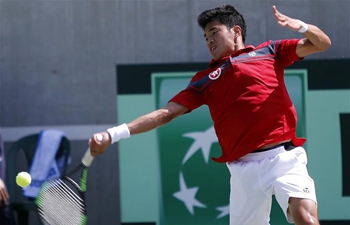WUHAN, April 8 (Xinhua) -- It is lunch time and dealers are busy bargaining and loading trucks with boxes of crayfish in a market in Qianjiang, a city in central China's Hubei Province famed for its crayfish.
Days later, customers in restaurants across China enjoy the delicacies, with some even appearing on foreign dining tables.
Run by Hubei Qianwang crayfish trading company, the market, with a trading volume of 120 million yuan (around 20 million U.S. dollars) last year, is one of the most prosperous of its kind in China.
Native to North America, crayfish were brought to east China's Jiangsu Province by a Japanese merchant in the 1920s or 1930s. They appeared in the plain in central China about 30 years ago, and villagers found the shellfish tasty and turned them into big business.
However, Nie Xiaofeng, general manager with the market, has new concerns.
"The new generation attach greater importance to health and their taste requirements for crayfish are higher, so we must guarantee the quality of the crayfish and transport them to customer tables as fast as possible," he said.
Another problem is the increasing number of dealers. There are about 70 dealers who are waiting for places in the market to sell their crayfish.
"We have to change as the traditional trading market can no longer meet customer needs," he added.
These new problems compel the market to upgrade itself. First, it is being enlarged to hold more dealers, and an online trading platform has been established.
Second, a new cold chain logistics service is being used to transport the crayfish with less damage and higher quality over long distance.
Third, a traceability system is under construction to create an open and transparent marketplace and help customers check the whole crayfish production process from farm to table.
The changes epitomize the supply-side structural reforms, taking place in nearly every chain of the crayfish industry in the city, home to about 1 million people.
Huashan Aquatic, a leading crayfish producer in the city, used to produce only crude crayfish but now it's changing its business strategy.
"Our company is endeavoring to extend the industrial chain by manufacturing high value-added products," said Liu Shixuan, an employee of the company.
Liu says that their crayfish are boiled with spices before sale.Customers can simply heat the crayfish and eat them. Besides spicy crayfish, they are exploring new tastes to meet the needs of different customers.
Crayfish shells were once dumped as useless trash. However, through cooperation with labs in universities, the company now turns the shells into precious resources.
Every year, about 100,000 tonnes of shells are used by Huashan to produce chitosan, a chemical substance that has commercial and biomedical uses.
Qianjiang is producing not only crayfish but also cooks and managers.
In the crayfish school, affiliated with Jianghan Art Vocational College in Qianjiang, students are given a choice of three majors: crayfish cooking and nutrition, catering management and marketing.
The school aims to train 10,000 crayfish cooks and another 10,000 to raise crayfish, as well as to help graduates open 1,000 Qianjiang crayfish chain stores across the country.
Li Jiahong, head of the crayfish school, said the school highly valued innovation and was upgrading and reforming.
"For example, more female students come to learn crayfish cooking but the traditional iron pans are too heavy for them, so we invented lighter electric rotating pans," Li said.
The school has also set up an innovation base, where startups related to the crayfish industry are established with favorable conditions offered.
"These startups cover the whole crayfish industry chain, ranging from spices for crayfish cooking to crayfish-related computer games," Li said.
In 2017, the production value of the crayfish industry in Qianjiang amounted to 23 billion yuan. "It will undergo more reforms in the coming years," Li added.

















